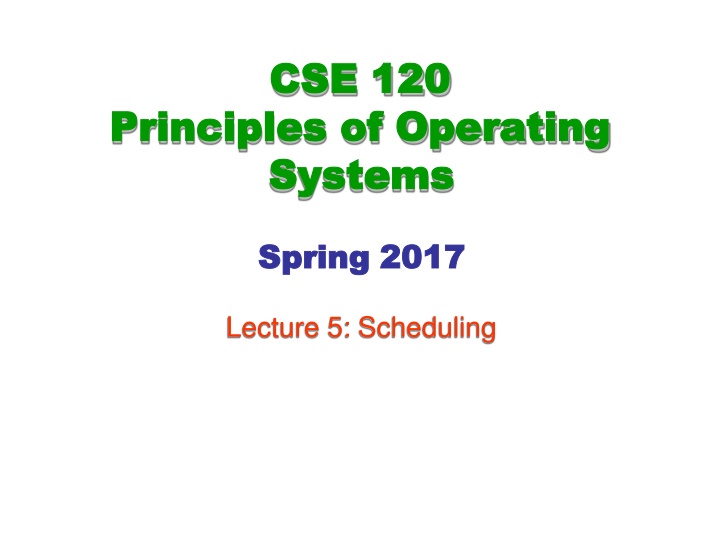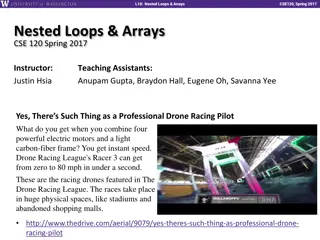
Understanding Scheduling in Operating Systems
Delve into the intricate world of scheduling in operating systems in this comprehensive overview. Explore the goals, algorithms, and challenges involved in managing processes efficiently to optimize system performance.
Download Presentation

Please find below an Image/Link to download the presentation.
The content on the website is provided AS IS for your information and personal use only. It may not be sold, licensed, or shared on other websites without obtaining consent from the author. If you encounter any issues during the download, it is possible that the publisher has removed the file from their server.
You are allowed to download the files provided on this website for personal or commercial use, subject to the condition that they are used lawfully. All files are the property of their respective owners.
The content on the website is provided AS IS for your information and personal use only. It may not be sold, licensed, or shared on other websites without obtaining consent from the author.
E N D
Presentation Transcript
120 Operating Systems Systems CSE CSE 120 Principles of Principles of Operating Spring Spring 201 2017 7 Lecture 5: Scheduling
Administrivia Administrivia Homework #1 due tomorrow Homework #2 out tomorrow October 20,2015 CSE 120 Lecture 8 Scheduling and Deadlock 2
Scheduling Scheduling Overview Overview In discussing process management and synchronization, we talked about context switching among processes/threads on the ready queue But we have glossed over the details of exactly which thread is chosen from the ready queue Making this decision is called scheduling In this lecture, we ll look at: Goals of scheduling Starvation Various well-known scheduling algorithms Standard Unix scheduling algorithm October 20,2015 CSE 120 Lecture 8 Scheduling and Deadlock 3
Multiprogramming Multiprogramming In a multiprogramming system, we try to increase CPU utilization and job throughput by overlapping I/O and CPU activities Doing this requires a combination of mechanisms andpolicy We have covered the mechanisms Context switching, how and when it happens Process queues and processstates Now we ll look at the policies Which process (thread) to run, for how long,etc. We ll refer to schedulable entities as jobs (standard usage) could be processes, threads, people, etc. October 20,2015 CSE 120 Lecture 8 Scheduling and Deadlock 4
Scheduling Scheduling Goals Goals Scheduling works at two levels in an operating system To determine the multiprogramming level the number ofjobs loaded into primary memory Moving jobs to/from memory is often calledswapping To decide what job to run next to guarantee goodservice Good service could be one of many differentcriteria These decisions are known as long-term and short- term scheduling decisions, respectively Long-term scheduling happens relatively infrequently Significant overhead in swapping a process out to disk Short-term scheduling happens relativelyfrequently Want to minimize the overhead ofscheduling Fast context switches, fast queue manipulation October 20,2015 CSE 120 Lecture 8 Scheduling and Deadlock 5
Scheduling Scheduling The scheduler (aka dispatcher) is the module thatmanipulates the queues, moving jobs to andfro The scheduling algorithm determines which jobs are chosento run next and what queues they waiton In general, the schedulerruns: When a job switches from running to waiting When an interrupt occurs (e.g., I/O completes) When a job is created or terminated We ll discuss scheduling algorithms in two contexts In preemptive systems the scheduler can interrupt a running job (involuntary context switch) In non-preemptive systems, the scheduler waits for a running job to explicitly block (voluntary context switch) October 20,2015 CSE 120 Lecture 8 Scheduling and Deadlock 6
Scheduling Scheduling Goals Goals Scheduling algorithms can have many different goals: CPU utilization (%CPU) Job throughput (# jobs/time) Turnaround time (Tfinish Tstart) Waiting time (Avg(Twait): avg time spent on wait queues) Response time (Avg(Tready): avg time spent on readyqueue) Batch systems Strive for job throughput, turnaround time (supercomputers) Interactive systems Strive to minimize response time for interactive jobs(PC) October 20,2015 CSE 120 Lecture 8 Scheduling and Deadlock 7
Starvation Starvation Starvation is a scheduling non-goal : Starvation is a situation where a process is prevented from making progress because some other process has the resource it requires Resource could be the CPU, or a lock (recallreaders/writers) Starvation usually a side effect of the sched. algorithm A high priority process always prevents a low priorityprocess from running on the CPU One thread always beats another when acquiring alock Starvation can be a side effect of synchronization Constant supply of readers always blocks out writers October 20,2015 CSE 120 Lecture 8 Scheduling and Deadlock 8
FCFS/FIFO FCFS/FIFO First-come first-served (FCFS), first-in first-out (FIFO) Jobs are scheduled in order of arrival to readyQ Real-world scheduling of people in lines (e.g.,supermarket) Can be preemptive, ornot. Jobs treated equally, no starvation Problem Average waiting time can be large if small jobs wait behind long ones (high turnaroundtime) You have a basket, but you re stuck behind someone with a cart October 20,2015 CSE 120 Lecture 8 Scheduling and Deadlock 9
Shortest Shortest Job First Job First (SJF) (SJF) Shortest Job First (SJF) Choose the job with the smallest expected CPU burst Person with smallest number of items tobuy Provably optimal minimum average waiting time AWT = (8 + (8+4)+(8+4+2))/3 = 11.33 AWT = (4 + (4+8)+(4+8+2))/3 = 10 AWT = (4+ (4+2)+(4+2+8))/3 = 8 AWT = (2 + (2+4)+(2+4+8))/3 = 7.33 October 20,2015 CSE 120 Lecture 8 Scheduling and Deadlock 10
Shortest Shortest Job First Job First (SJF) (SJF) Problems Impossible to know size of CPU burst Like choosing person in line without looking inside basket/cart How can you make a reasonableguess? Can potentially starve Flavors Can be either preemptive or non-preemptive Preemptive SJF is called shortest remaining time first(SRTF) October 20,2015 CSE 120 Lecture 8 Scheduling and Deadlock 11
Priority Priority Scheduling Scheduling Priority Scheduling Choose next job based on priority Airline checkin for first classpassengers Can implement SJF, priority = 1/(expected CPU burst) Also can be either preemptive ornon-preemptive Problem Starvation low priority jobs can wait indefinitely Solution Age processes Increase priority as a function of waiting time Decrease priority as a function of CPU consumption October 20,2015 CSE 120 Lecture 8 Scheduling and Deadlock 12
Round Robin Round Robin (RR) (RR) Round Robin Excellent for timesharing Ready queue is treated as a circular queue(FIFO) Each job is given a time slice called a quantum A job executes for the duration of the quantum, or untilit blocks or is interrupted No starvation Can be preemptive or non-preemptive Problem Context switches are frequent and need to be veryfast October 20,2015 CSE 120 Lecture 8 Scheduling and Deadlock 13
Combining Combining Algorithms Algorithms Scheduling algorithms can be combined Have multiple queues Use a different algorithm for eachqueue Move processes among queues Example: Multiple-level feedback queues (MLFQ) Multiple queues representing different job types Interactive, CPU-bound, batch, system,etc. Queues have priorities, jobs on same queue scheduledRR Jobs can move among queues based upon executionhistory Feedback: Switch from interactive to CPU-bound behavior October 20,2015 CSE 120 Lecture 8 Scheduling and Deadlock 14
Unix Unix Scheduler Scheduler The canonical Unix scheduler uses a MLFQ 3-4 classes spanning ~170 prioritylevels Timesharing: first 60priorities System: next 40priorities Real-time: next 60priorities Interrupt: next 10(Solaris) Priority scheduling across queues, RR within a queue The process with the highest priority always runs Processes with the same priority are scheduledRR Processes dynamically change priority Increases over time if process blocks before end ofquantum Decreases over time if process uses entirequantum October 20,2015 CSE 120 Lecture 8 Scheduling and Deadlock 15
Motivation of Unix Motivation of Unix Scheduler Scheduler The idea behind the Unix scheduler is to reward interactive processes over CPU hogs Interactive processes (shell, editor, etc.) typically run using short CPU bursts They do not finish quantum before waiting for moreinput Want to minimize response time Time from keystroke (putting process on ready queue)to executing keystroke handler (processrunning) Don t want editor to wait until CPU hog finishesquantum This policy delays execution of CPU-bound jobs But that s ok October 20,2015 CSE 120 Lecture 8 Scheduling and Deadlock 16
Scheduling Scheduling Overhead Overhead Operating systems aim to minimize overhead Context switching takes non-zero time, so it is pureoverhead Overhead includes context switch + choosing nextprocess Modern time-sharing OSes (Unix, Windows, ) time- slice processes in ready list A process runs for its quantum, OS context switchesto another, next process runs,etc. A CPU-bound process will use its entire quantum (e.g.,10ms) An IO-bound process will use part (e.g., 1ms), then issueIO The IO-bound process goes on a wait queue, the OSswitches to the next process to run, the IO-bound process goes back on the ready list when the IOcompletes October 20,2015 CSE 120 Lecture 8 Scheduling and Deadlock 17
Utilization Utilization CPU utilization is the fraction of time the system is doing useful work (e.g., not context switching or idle) If the system has Quantum of 10ms + context-switch overhead of0.1ms 3 CPU-bound processes + round-robinscheduling In steady-state, time is spent as follows: 10ms + 0.1ms + 10ms + 0.1ms + 10ms +0.1ms CPU utilization = time doing useful work / totaltime CPU utilization = (3*10ms) / (3*10ms + 3*0.1ms) =30/30.3 If one process is IO-bound, it will not use full quantum 10ms + 0.1ms + 10ms + 0.1ms + 1ms +0.1ms CPU util = (2*10 + 1) / (2*10 + 1 + 3*0.1) =21/21.3 October 20,2015 CSE 120 Lecture 8 Scheduling and Deadlock 18
Scheduling Scheduling Summary Summary Scheduler (dispatcher) is the module that gets invoked when a context switch needs to happen Scheduling algorithm determines which process runs, where processes are placed on queues Many potential goals of scheduling algorithms Utilization, throughput, wait time, response time,etc. Various algorithms to meet these goals FCFS/FIFO, SJF, Priority, RR Can combine algorithms Multiple-level feedback queues Unix example October 20,2015 CSE 120 Lecture 8 Scheduling and Deadlock 19
Thread Thread Scheduling Scheduling Discussed scheduling in the context of processes, but thread scheduling is analogous Process scheduling and thread scheduling are essentially the same for kernel supported threads User-level thread facilities have analogous user-level thread scheduler February 1,2007 CSE 120 Lecture 8 Scheduling and Deadlock 20


